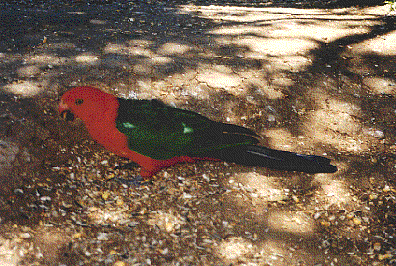






Birds play an important part in a healthy garden by keeping insect numbers under control. They also give our family much enjoyment as they flutter from one part of our garden to another. Our home garden includes a wide range of exotic plants with very few natives, therefore the food supply and shelter available in our garden is not as adequate as it could be. I have always tried however,to provide plenty of water for the birds with the addition of birdbaths (see Features" page). As the years progress, we aim to provide a welcoming habitat for the birds by selecting a wide range of plants that have the fragrance and nectar attractive to them.
Also the Wishing Well bucket filled with parrot-mix makes an alluring addition to the landscape as well as providing for our feathered friends. I do try to feed the birds only small amounts of seed so they do not become dependent on artificial feeding.( one for me! one for you! one for me! one for you! one for me!)
As I mentioned, Australian birds are attracted to colourful, nectar-filled flowers, seeds, fruit and insects so please email. me if you have any suggestions.



The wonderful book, Creating a Native Garden for Birds.(ed Frances Hutchison, Simon Schuster Australia. 1993. informs that, "Among the approximately 700 birds recorded in Australia, about 500 are land birds that breed within the country, more than 100 are water and sea birds and the rest are non breeding migrants and occasional visitors. We have a large proportion of the worlds's honeyeaters (about sixty-six species), parrots (more than fifty species) and finches (about twenty species.) These are among the most vivid and beautiful birds. It's important that they and all native birds flourish in safety and are never reduced to endangered levels."
Some of the feathered friends that visit our garden are so wonderfully varied in character. As I sit here at the computer a black and white magpie struts with head held high on the verandah just outside my window. He casually pecks and eats a dead moth and continues his search for other appetizing meals.
Over the last few weeks I have been observing an interesting natural occurance. Our "sacrificial lemon tree" planted in a lovely terracotta pot is home to quite an abundance of wildlife. A tiny black and white caterpillar has devoured many leaves, grown to a noteable size and this morning I noticed it was beginning to spin its cocoon.
Update.The butterfly has flown away and if not eaten will continue this amazing life cycle. For more information visit the buterfly website at the bottom of my homepage.